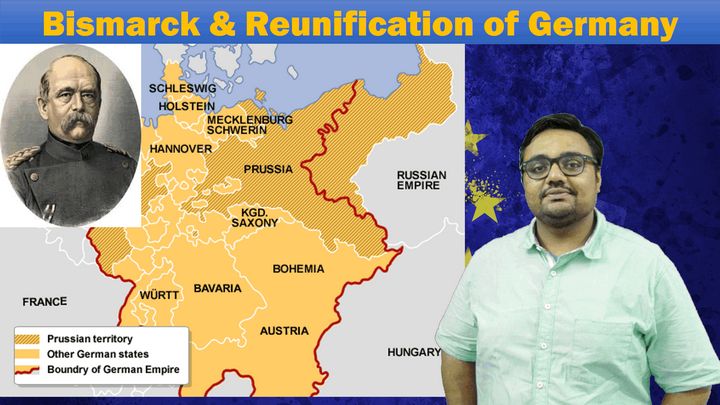- Prologue
- WHRd/P1: Redrawal of National boundaries: Meaning & factors
- WHRd/P2: Vienna Congress & Metternich System
- WHRd/P3: Reunification of Italy
- WHRd/P4: Reunification of Germany
Prologue
- In past lecture, Pratik Nayak covered the American and French revolutions for World History for General Studies Mains Paper 1 (GSM1).
- Now moving forward with next topic: redrawal of boundries and reunification of Germany and Italy.
- PowerPoints available under Mrunal.org/download goto mediafire folder: “1_Powerpoint” => “3_History_Pratik” à “World History”
WHRd/P1: Redrawal of National boundaries: Meaning & factors
In this lecture, Pratik Nayak discusses the meaning of redrawal of boundaries and the intellectual, cultural, political and economic factors behind the redrawal of boundaries.

Youtube Link: youtu.be/VLFYnsL5zj4
WHRd/P2: Vienna Congress & Metternich System
On April 4, 1814, a defeated Napoleon abdicated the throne, marking the end of a catastrophic quarter-century of revolution and warfare. The French Revolution (1789–1799) and the Napoleonic Wars (1799–1815) had profoundly shaken Europe and a new atmosphere of international cooperation emerged in response. The Congress of Vienna was the first instance in which an international body met together in a single place to discuss the future of Europe. The congress included representatives from more than 200 nations and princely states.

The dominant figure and host of the Congress of Vienna was Austria’ s foreign minister, Prince Klemens von Metternich (1773–1859). At the Congress of Vienna, Metternich was chiefly responsible for creating the balance of power in Europe. For the next 30 years, the Austrian would dedicate himself to stabilizing and consolidating this balance. The so-called Metternich system ensured stability by censoring political and religious views that threatened the conservative status quo.
Youtube Link: youtu.be/9K8hp86vfIY
WHRd/P3: Reunification of Italy

Like Germany, Italy was also divided into a number of states. The major states in the early 19th century Italy were Sardinia, Lombardy, Venetia, Kingdom of the Two Sicilies (Sicily and Naples), Papal States, Tuscany, Parma and Modena. Giuseppe Mazzini and Giuseppe Garibaldi started Young Italy movement. It aimed at the independence and unification of Italy and the establishment of a republic there. Later the Prime minister of Sardinia Count Cavour, took the initiative of uniting Italy
Youtube Link: youtu.be/dKOZorTVI6E
WHRd/P4: Reunification of Germany

In the 18th century, Germany was divided into a number of states. Some of these states were very small and did not extend beyond the limits of a city. During the Napoleonic wars, many of these states ceased to exist. At the end of the wars there were still thirty-eight independent states in Germany. Among them Prussia, Wurttemberg, Bavaria, and Saxony were fairly large. The division of Germany into a number of states had hampered the economic development of Germany. The social and political system in these states was also very backward. Bismarck, a Prussian aristocrat began Policy of “blood and iron” to reunite them.
Youtube Link: youtu.be/0DKFn_kvlM0

![[Summary] Budget & Economic Survey 2018 Gist for the UPSC IAS/IPS Interviews](https://mrunal.org/wp-content/uploads/2018/02/c-bes18-basanti-500x383.jpg)
![[BES171] Banking-Classification: Wholesale Banks, Cooperative Banks, DFI AIFI, MUDRA Bank, Islamic Bank, NBFCs & Indigenous Moneylenders](https://mrunal.org/wp-content/uploads/2017/05/c-bes171-evo-2-500x383.gif)
![[BES171] Banking-Classification: RBI Structure Functions, Nationalization, Scheduled Banks, Merger of SBI Associate Banks & BMB, Private Banks, SFB & Payment Banks](https://mrunal.org/wp-content/uploads/2017/02/c-bes171-cover-500x383.gif)
Sir, I am preparing UPSC for 2017, but I have choose Hindi medium for examination. Can u guide me and upload the material in Hindi medium.
Does anybody has Rohini as Mains 2016 center? Plz drop mail at:
asif.ak64.ak64@gmail.com
Bhai video de do … Exam ko ab kuch din hin baaki hain
Dear Sir,
As the clock ticks away restlessness palpitation increases with profuse sweating and it’s your video that provides us with the ray of hope that we can hold onto until the last. So please sir this is an earnest request from the whole of mankind to please provide the video or at least the ppt at the earliest. There is two wars to be fought and the theatrics of mikhail gorbachev to follow.
Dhanyavad
Aapka agyakari
Mr. Bing
where is the link to download the ppts of above video presentation ??? Required for revision. Plz somebody help.
Useful info sir.. Thanx for publish this useful Article…
Thanks sir,